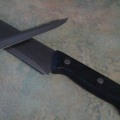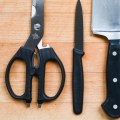Sharpening a convex edge knife is an art form that requires skill and precision. It's a delicate process that requires patience, practice, and the right tools. Whether you're a professional chef or just a home cook, having a sharp knife is essential to your success in the kitchen. A properly sharpened convex edge knife can make all the difference when slicing and dicing ingredients for your meals.
With the right technique, you can ensure that your knives are always razor-sharp and ready to use. In this article, we will discuss the basics of sharpening a convex edge knife, as well as some tips to help you achieve optimal results. Read on to learn more about sharpening your knives and how to get that perfect edge!Sharpening a convex edge knife requires practice and patience, and while it can seem daunting at first, with the right tools and techniques you can get a perfectly sharp edge every time. To get started, it is important to know which type of knives require a convex edge.
Many pocket knives and hunting knives, as well as Japanese-style knives, have a convex edge. This type of edge is sturdier than a flat edge, and holds up better over time.
To sharpen a convex edge knife
, you will need a few basic tools. The most important tool is a sharpening stone, which can range from coarse to fine grade.Honing oil is also necessary to lubricate the stone and keep it from clogging with metal particles. Additionally, you may need a strop for polishing the blade after sharpening.
The sharpening process
involves using strokes that go from heel to tip of the blade. Start with the coarsest stone and use slow, even strokes.Work your way up to the finer stones until you have achieved the desired sharpness. You will also need to use honing oil with each stone in order to lubricate and remove metal particles.
The key steps in sharpening a convex edge knife
include:- Starting with the coarsest stone, make long strokes from the heel to the tip of the blade.
- After each stroke, use the finer stone, continuing in long strokes.
- Work up through the grades of stones until you have achieved the desired sharpness.
- After sharpening, use honing oil on the blade and wipe clean.
- Polish the blade with a strop if desired.
If it slices through easily, then your knife is sharp enough.
Common mistakes to avoid
when sharpening a convex edge knife include using too much pressure on the stone or not using enough oil. Too much pressure can damage the blade while too little oil will lead to clogging of the stone. Additionally, it is important to sharpen both sides evenly in order to get an even, durable edge.Common Mistakes to Avoid
When sharpening a convex edge knife, there are several common mistakes that should be avoided.First, applying too much pressure when sharpening can lead to an uneven edge, and can even cause the blade to chip or break. It is important to use light, even pressure when sharpening, as too much pressure can damage the blade. Second, using the wrong grit of stone or sharpener can also lead to an uneven edge. Coarse grits are best suited for initial shaping of the blade, while finer grits are used for honing and polishing the edge.
Third, using a stone that is too hard for the type of knife being sharpened can also cause the blade to chip or break. It is important to use a stone that is appropriate for the type of steel used in the blade. Finally, it is important to remember that sharpening a convex edge knife requires patience and practice. Even experienced sharpeners may find themselves struggling when attempting to create a perfect edge on a convex blade. It is important to take your time and use slow, even strokes when sharpening a convex edge knife.
Step-by-Step Instructions for Sharpening a Convex Edge Knife
Sharpening a convex edge knife requires patience and practice to get the perfect sharp edge.To sharpen a convex edge knife, you will need specific tools and materials. The following step-by-step instructions will help you create a sharp and durable edge. 1.Start by preparing your work surface. You'll need a flat, hard surface to work on, like a stone or a piece of wood.
2.Secure the knife in a vise or clamp if needed. This will ensure that your knife stays in place while you sharpen it. 3.Select the correct grinding stone for your knife. For a convex edge, use a medium to fine-grit stone.
4.Begin sharpening by holding the knife at a 15-20 degree angle against the stone and moving the blade in an arc-like motion. 5.Once you've sharpened the blade, switch to a finer grit stone to refine the edge. 6.Finish sharpening by stropping the blade on a leather strop or another surface with honing compound. 7.Clean the knife and test it on paper or other material before using it.
Tools and Materials for Sharpening a Convex Edge Knife
Sharpening a convex edge knife requires specific tools and materials. The most important tool is a sharpening stone. The type of stone you use depends on the hardness of your blade. Harder blades require a finer grade stone, while softer blades can be sharpened with a coarser stone.Honing oil is also necessary when sharpening a convex edge knife; this helps to lubricate the blade while sharpening and prevents it from becoming damaged during the process. In addition to the sharpening stone and honing oil, you may want to consider other tools and materials. For example, a honing guide can help maintain the angle of your blade while you sharpen, while a honing steel can help realign the edge of the blade if it becomes bent or warped. You may also want to invest in a whetstone holder to keep your sharpening stone in place. Finally, you may want to purchase a strop for polishing the blade and giving it a mirror-like finish.
Testing the Sharpness of Your Convex Edge Knife
Once you have finished sharpening your convex edge knife, it is important to test the sharpness of the blade.Testing the sharpness of your convex edge knife is a simple process, and it will help you determine if you need to do more work or if your knife is ready for use. To test the sharpness of your convex edge knife, take a piece of paper and fold it in half. Place the blade at a 45 degree angle and slowly draw the blade down the paper, then release it. If the blade cuts through the paper with ease, then it is sharp enough to be used.
If it does not cut through the paper easily, then you should repeat the sharpening process. Another way to test the sharpness of your convex edge knife is to use a honing rod. Place the honing rod at a 20-degree angle on a cutting board and slide the blade along the length of the rod in a back and forth motion. If you can easily shave a few hairs off your arm with the blade, then it has been sharpened properly.
If not, then you need to go back and do more work on sharpening your convex edge knife. Testing the sharpness of your convex edge knife is an important step in getting a perfect edge. By testing the sharpness of your blade, you can make sure that it is ready for use and that it will be able to handle whatever task you put it up against. Sharpening a convex edge knife is an art that requires practice and patience. The key to success lies in having the right tools and materials, as well as following the step-by-step instructions for creating a sharp and durable edge.
It's important to take the time to practice your skills and master the technique to achieve the perfect sharp edge every time. Common mistakes to avoid include dulling the blade, using too coarse of a grit, and not using enough pressure when sharpening. With the right knowledge and practice, you can sharpen your convex edge knife with confidence.







Leave Reply